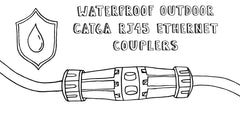Payment methods accepted

When Should I Replace Ethernet Cable?
Written by Don Schultz, trueCABLE Senior Technical Advisor, Fluke Networks Copper/Fiber CCTT, BICSI INST1, INSTC, INSTF Certified
Anyone who has installed Ethernet cabling has likely had to remove older runs, especially if you do it for a living. The short answer to the question, “When should I replace Ethernet cable?” is: When the old cable will no longer perform the function required of it.
A simple answer? Sure, but there are core reasons why an Ethernet cable replacement should occur. Here are the most likely suspects:
- The Ethernet cable has become physically damaged and it has failed, common in outdoor installations
- The Ethernet cable is not of modern specification to support current network equipment speeds
- A network equipment upgrade will soon take place and the existing cable will not support the higher bandwidth
- A move from Ethernet over copper cable to Ethernet over fiber optic cable is in process
Taking the possibilities above, does it mean ALL of the existing cabling should be removed? Not necessarily, but it might make sense. Here are the scenarios when complete cable change-over should occur:
- Switching from 1G network equipment to 10G equipment, and the current cabling is Cat5e or Cat6. If the runs must all exceed 165 feet (55 meters), then Cat6A cable should be used.
- Cat5 cable (no “e”). That cable is still out there and in use! Cat5 cable officially supports 100 Mbp/s speed to 328 feet (100 meters). The 1G (1000 Mbp/s) speed is most common now. There is not much equipment these days that does not support at least 1G speed. This requires Cat5e cable or above, and Cat5e is not expensive.
- Outdoor runs where the cable is not CMX (outdoor rated). Any cable that is not CMX is at serious risk of damage related to exposure, due to seasonal changes and sunlight. Any cable run outdoors that is not CMX rated needs replacement as soon as possible.
- A remodel of the structure is taking place. This is a brilliant time to replace runs with an inappropriate cable jacket type. An example is riser rated cable (CMR) that is run inside the HVAC area (plenum). During remodeling a permit is typically required and a keen-eyed inspector will look at the jacket rating. Like it or not, you may be forced to replace that cable with plenum rated cable. Likewise, if CM (the most basic jacket type of all) was run inside walls, then you should run riser rated instead. This blog article goes over why this is critical: Facts About Ethernet Cable Jacket Ratings.
- CCA (copper clad aluminum) cable was run, and you discovered just how bad of an idea that was. Terminations going bad randomly? Cable conductors breaking inside of walls for seemingly inexplicable reasons? Read up on the horrors of this situation here: Check Your Specs, CCA is Different from Solid Copper.
- At some point in time someone tried to save money and ran stranded copper Ethernet patch cabling inside the structure. This generally happens because the cable already had RJ45 plugs attached and the expertise and tools were not available to terminate bulk structure cable. Ethernet patch cable is not the same as structure cable. For example, patch cable is used between an RJ45 wall jack and a computer inside of the same room. Structure cable is designed for drops with connections from one room to another. Patch cable is extremely useful for quick connections inside the same room and can withstand frequent handling. They will cause issues with PoE (power over Ethernet) and data stability over longer distances. DC resistance is the culprit to consider with stranded cables.
What about when internet cable replacement isn’t necessary? There are a couple of scenarios where it is appropriate to keep around some of that old cable, but only in limited circumstances such as:
- You have runs of Cat6, the cable jacket ratings are appropriate for where the cable runs, but the run will not exceed 55 meters or 165 feet. In this case, 10 Gigabit Ethernet speeds can be achieved without the need for Cat6A. This article provides a better insight into the caveats: The Difference Between Cat6 vs Cat6A Ethernet Cable.
- You have runs of plain old Cat5 running into a space full of expensive and difficult to replace production equipment (punch presses, injection molding presses, etc.). That equipment does not, and never will, communicate at a speed higher than 100 Mb/s. Replacement of machines like that is not likely anytime soon, as the costs run into the millions of dollars.
Tips and Good To Know
- Can Ethernet cables go bad? Yes, but not in a way you might think. Have you ever worked on very old electrical wiring (like 70 years old) where the copper wires have become brittle and difficult to bend? Copper does age, but it takes time. PVC jackets on Ethernet cable does “off gas” and lose composition over time as well. Fortunately, we are not quite there yet. These situations take many years or even decades. We are only beginning to see some of the earliest Cat3 and Cat5 Ethernet cable get to this point. This cable might show signs of extreme aging, especially if the environmental conditions were not ideal.
- When replacing cabling, be careful of cutting the wrong cable run! I know it seems like an obvious point, but I actually had to learn the hard way. Yes, I did cut the wrong cable one day! That day was not fun.
- When cutting through cabling, be absolutely sure the cable has been disconnected from the switch end and device end first. Again, I learned the hard way on that too. I cut a cable that had PoE power running through it. I was never in danger, as this is low voltage. What was in danger (and died) was the associated switch port.
In the final analysis, the cable is part of a system. Every component must work in order for the system to work, so it’s important to replace Ethernet cable when necessary. Disregard the cable part of the system at your own peril!
trueCABLE presents the information on our website, including the “Cable Academy” blog and live chat support, as a service to our customers and other visitors to our website subject to our website terms and conditions. While the information on this website is about data networking and electrical issues, it is not professional advice and any reliance on such material is at your own risk.

































